Subjects covered in the KICKDRILL App
Subjects covered in the KICKDRILL App
The subjects covered mostly follow the syllabus defined by IWCF from 2017 (current valid version). In addition there are some added topics outside of the mandatory subjects. These are marked as such. If you are following the IADC certification, the syllabus will in principle cover the same topics but in a sligthly different setup.
Questions around this topic aim to increase awareness around the following themes…:
- Hydrostatic, Formation and Fracture Pressures
- Primary and Secondary Well Control
- General Well Control Equipment

A question that can be found under “Pressures and Limits”:
“We are circulating out a kick using the Weight and Weight method. After 200 of the 1338 strokes string capacity, we decide to increase the flowrate from 30 to 45 strokes. The SCR at 30 SPM was 32 and 46 up riser and choke respectively. Our stepdown chart calculated 3,4 Bar/100 Strokes and our FCP is 36.7 Bar. What will be our new expected Drillpipe pressure?. Please check Image…”
Questions around this topic aim to increase awareness around the following themes…:
- Well Barriers
- Barrier Concept
- Criterias for Barriers
- Equipment Acceptance Criterias
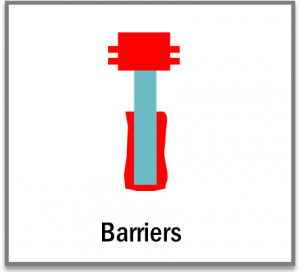
A question that can be found under “Barriers”:
“When shall a Well Barrier be tested? (4 answers)”
Questions around this topic aim to increase awareness around the following themes…:
- Operational drills
- Prepareness for unforseen events
- How to identify failures when circulating out an influx

A question that can be found under “Risk, Drills and Contingency Management”:
“According to API 59, 11.3.2; how often should a BOP drill be performed?”
Questions around this topic aim to increase awareness around the following themes…:
- How and why does a kick develop
- Lost circulation
- Effects from gas cut mud
- Surge and Swab effects
- Kicks caused by not following procedures during tripping

A question that can be found under “Causes of Kicks”:
“Our overbalance is 21 bar. The mud weight is 1.63 sg. How far theoretically could the fluid level drop before the well is in static underbalance? “
Questions around this topic aim to increase awareness around the following themes…:
- Early Kick Detection
- Shallow Gas
- Top Hole Drilling
- Identification
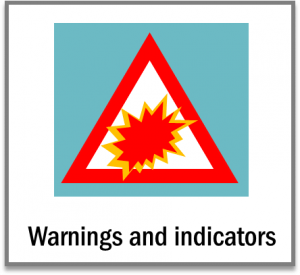
A question that can be found under “Warnings and indicators”:
“For a kick to develop, some conditions need to be met: (select 3 answers)”
Questions around this topic aim to increase awareness around the following themes…:
- Slow Circulation Rates (SCR)
- Issues around MAASP and Fracture pressures
- Leak Off Tests and Formation Integtity Tests

A question that can be found under “MAASP-SCR-LOT”:
“A fixed rig is placed at a waterdepth of 100 m. We need to calculate the setting depth for the conductor. The flow line is 20 m above the mean sea-level. The formationstrength is 0.154 bar/m calculated from seabed down. Sea-water gradient is 0.1007 bar/m. The plan is to drill out of the the conductor with 1.10 sg mud. What is the minimum setting depth (from RKB) for the conductor to prevent losses? Use nearest whole number.”
Questions around this topic aim to increase awareness around the following themes…:
- Different types of influx and the physics around it
- Boyles law
- Kicks in horizontal wells
- Gas breakouts during circulation

A question that can be found under “Influx and behaveour”:
“We have shut in a well in a long horizontal section after having taken a 800 liter kick in a 8 1/2″ section. The ROP has been slow. We have a float in the string and need to pump up the float to read off the SIDPP. We read 30 Bar on the Casing side. What pressure could we expect on the Drillpipe pressure gauge?”
Questions around this topic aim to increase awareness around the following themes…:
- Configuration of lineups
- Monitoring pressures
- Shut-in methods during drilling and tripping
- Confirmation of the shut-in
- Hang off
- Limitations
- Float in string
- Interpretations of pressures

A question that can be found under “Shut-in Procedures”:
“In a well kill scenario; what type(s) of influx will expand in a shut in well?”
Questions around this topic aim to increase awareness around the following themes…:
- The different principles
- Drillers Method
- Weight and Wait
- Volumetric and Lubrication
- Choke Line Friction (SS)
- Stripping
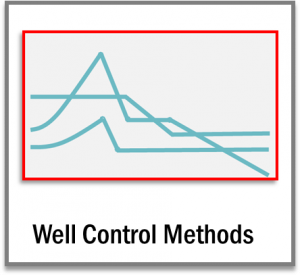
A question that can be found under “Well Control Methods”:
“The driller has pumped 300 strokes after starting the drillers method but increased the pump speed and thereby maintaining the ICP after having registered a leak in the lines just after the pump. What would this do with the Bottom Hole Pressure?”
Questions around this topic aim to increase awareness around the following themes…:
- Inputs for sereral killsheets are given where candidate can fill out the complete sheet, also some additional tasks not part of the exam questions
- KMW-
- ICP
- FCP
- IDCP
- Stepdown

A question that can be found under “Kill Sheets”:
“Please see the atttached Image for SubSea well 12. Calculate:
KMW, ICP, FCP, IDCP, Stepdown/100 strk”
The Practice modules has examples from several KillSheet scenarios, and each Exam has questions from one spesific KillSheet scenario. The latter case scenarios may not be found in the Practice sessions for user challenge purposes.
Questions around this topic aim to increase awareness around the following themes…:
- Factors that need to be concidered when running casing and performing cementing operations
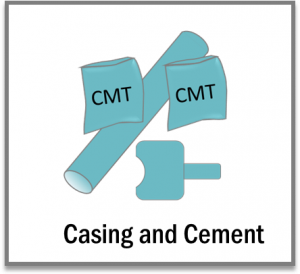
A question that can be found under “Casing and Cement”:
“We have cemented the cemented casing in place and are now Waiting on Cement (WOC). As the cement is hardening, how is the initial bottom hole pressure affected?”
Questions around this topic aim to increase awareness around the following themes…:
- Ram Types
- Annular Preventer
- Outlets
- Diverters
- Flanges and Gaskets

A question that can be found under “Blow Out Preventers”:
“Which Flanges with the following Ring Gaskets require periodic tigthening? (see image)”
Questions around this topic aim to increase awareness around the following themes…:
- Safety Valves
- Chokes
- Degasser Equipment

A question that can be found under “Safety Valves, Choke and Gas Equipment”:
“We are drilling and current depth is 2370m. The driller registers an increase in flow. He picks of bottom and shuts in the well on the annular preventer. There is a float in the drillstring. He notes down the pressures which then reads zero pressure on the Drillpipe and 37 Bar on the casing side. What is the correct procedure to do to obtain DP pressure?”
Questions around this topic aim to increase awareness around the following themes…:
- Test requirements
- Pressure Testing
- Function Testing
- Limitations, frequencies and requirements

A question that can be found under “Testing”:
“The BOP components shall be pressure tested to a stable test pressure that is maintained for a minimum of how many minutes with no visible leak (with reference to API)?”
Questions around this topic aim to increase awareness around the following themes…:
- General principles and functions
- Operating Pressures
- Problem identificaton
- Confirmation of functions
- Accumulators
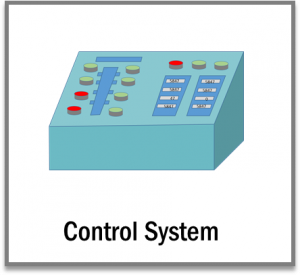
A question that can be found under “Control System”:
“To connect the riser to the LMRP and the BOP to the wellhead we use a special connector. This is controlled by hydraulic pressure activated through the BOP panel. What is the maximum unlatch time for this connector?”
Questions around this topic aim to increase awareness around the following themes…:
Several situations are given where the user will interpret the signals seen in the Control System. An image of the Control system key parameters are given and the user selects the most likly cause of the problem.
Questions around this topic aim to increase awareness around the following themes…:
As the kick is circulated out, several things can happen. The choke can plug, the pumps can stop, you can loose a jet etc. During the circulation you may also have built too much overpressure or have moved into underbalance and will need to adjust. The app will run through several of these scenarios and guide you through to the right answer. These questions are asked in the right sequence starting with “starting to circulate” and will continue until the influx is circulated out past the choke. Several problems are given on the way . Each exam has one Circulating Out scenario from one spesific case.
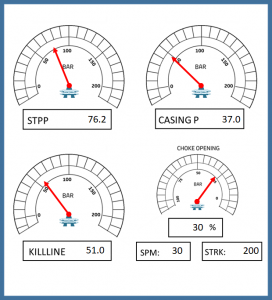
Questions around this topic aim to increase awareness around the following themes…:
These topics are usually not part of exams given at standard well control courses but may be useful for the candidate to understand and to know how to calculate.
- Calculating Kick Tolerance:
- The KickDrill App explains this issue further and gives an example of how to calculate Kick Tolerance. Can be used as a template for calculating KT on your well.
- Volumetric method when SIDPP is not available
- Case scenario of time taken and volume required to evacuate out gas when SIDPP is not available
- Calculating required Depth and amount of test fluid required during a Negative Pressure Inflow Test
- Usually not given at exams but the app goes through a case scenario

